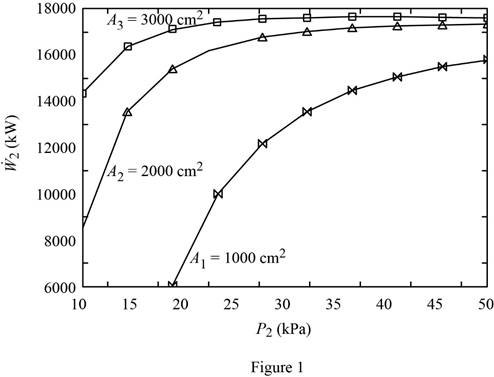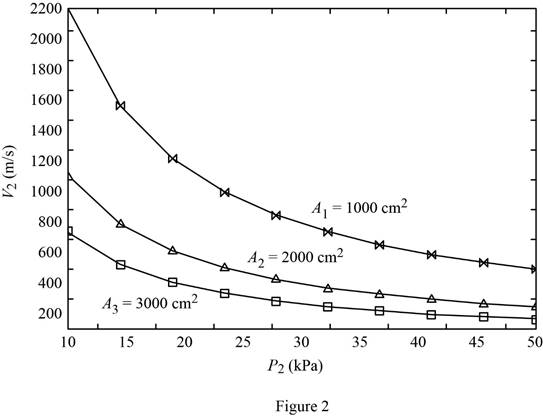
Concept explainers
Reconsider Prob. 5–178. Using appropriate software, investigate the effects of turbine exit area and turbine exit pressure on the exit velocity and power output of the turbine. Let the exit pressure vary from 10 to 50 kPa (with the same quality), and let the exit area vary from 1000 to 3000 cm2. Plot the exit velocity and the power outlet against the exit pressure for the exit areas of 1000, 2000, and 3000 cm2, and discuss the
results.
5–178 Steam enters a turbine steadily at 7 MPa and 600°C with a velocity of 60 m/s and leaves at 25 kPa with a quality of 95 percent. A heat loss of 20 kJ/kg occurs during the process. The inlet area of the turbine is 150 cm2, and the exit area is 1400 cm2. Determine (a) the mass flow rate of the steam, (b) the exit velocity, and (c) the power output.
Plot the exit pressure against power output of turbine and exit pressure against exit velocity for varying pressure from
Answer to Problem 179RP
The plot for the exit pressure against power output of turbine and exit pressure against exit velocity for varying pressure from
Explanation of Solution
The turbine operates steadily. Hence, the inlet and exit mass flow rates are equal.
Write the formula for inlet mass flow rate.
Here, the cross-sectional area is
At inlet:
The steam is at the state of superheated condition.
Refer Table A-6, “Superheated water”.
Obtain the inlet enthalpy
The turbine operates steadily. Hence, the inlet and exit mass flow rates are equal.
Write the formula for exit mass flow rate.
Here, the cross-sectional area is
Rearrange the Equation (II) to obtain exit velocity
At exit:
Consider the exit pressure
The steam is with the quality of
Write the formula for exit enthalpy
Write the formula for exit specific volume
Here, the enthalpy is
Refer Table A-5, “Saturated water—Pressure table”.
Obtain the following corresponding to the pressure of
Consider the steam flows at steady state. Hence, the inlet and exit mass flow rates are equal.
Write the energy rate balance equation for one inlet and one outlet system.
Here, the rate of heat transfer is
The refrigerant flows at steady state through the compressor. Hence, the rate of change in net energy of the system becomes zero.
Heat loss occurs at the rate of
The Equations (VI) reduced as follows to obtain the work output
Here,
Rewrite the Equation (VII) as follows.
Conclusion:
Substitute
Substitute
Equation (V).
Substitute
Consider the exit area
Substitute
Equation (III).
Substitute
The exit velocity
Using excel spread sheet, the exit velocity
| S.No. | |||
| 1 | 10 | 2253.540216 | –22171.1196 |
| 2 | 15 | 1539.230498 | –514.857057 |
| 3 | 20 | 1174.871104 | 7295.806083 |
| 4 | 25 | 952.9435377 | 10965.91684 |
| 5 | 30 | 803.2150134 | 12968.62817 |
| 6 | 40 | 613.4390747 | 14943.44488 |
| 7 | 50 | 497.7670121 | 15822.49054 |
Table 1
Similarly, the exit velocity
| S.No. | |||
| 1 | 10 | 1126.770108 | 8623.292217 |
| 2 | 15 | 769.6152491 | 13851.56455 |
| 3 | 20 | 587.435552 | 15665.73428 |
| 4 | 25 | 476.4717689 | 16472.41662 |
| 5 | 30 | 401.6075067 | 16880.6829 |
| 6 | 40 | 306.7195374 | 17225.27947 |
| 7 | 50 | 248.883506 | 17324.918 |
Table 2
Similarly, the exit velocity
| S.No. | |||
| 1 | 10 | 751.180072 | 14325.96107 |
| 2 | 15 | 513.0768327 | 16512.01299 |
| 3 | 20 | 391.6237013 | 17215.72099 |
| 4 | 25 | 317.6478459 | 17492.1388 |
| 5 | 30 | 267.7383378 | 17605.13749 |
| 6 | 40 | 204.4796916 | 17647.84143 |
| 7 | 50 | 165.9223374 | 17603.1453 |
Table 3
Refer Table 1, 2, and 3.
Plot the graph for the exit pressure

Refer Table 1, 2, and 3.
Plot the graph for the exit pressure

Want to see more full solutions like this?
Chapter 5 Solutions
THERMODYNAMICS (LL)-W/ACCESS >IP<
Additional Engineering Textbook Solutions
Foundations of Materials Science and Engineering
Applied Statics and Strength of Materials (6th Edition)
DESIGN OF MACHINERY
Thermodynamics: An Engineering Approach
Fundamentals Of Thermodynamics
Vector Mechanics for Engineers: Dynamics
- Steam flows steadily through an adiabatic turbine. The inlet conditions of the steam are 10MPa, 400°C, and 100 m/s, and the exit conditions are 10 kPa, 88 percent quality, and 50m/s. The mass flow rate of the steam is 18 kg/s. Determine (a) the change in kinetic energy,(b) the power output, and (c) the turbine inlet area.arrow_forwardIn large compressors, the gas is often cooled while being compressed to reduce the power consumed by the compressor. Explain how cooling the gas during a compression process reduces the power consumption.arrow_forwardSteam enters a turbine with an enthalpy of 3300 KJ/kg and leaves with an enthalpy of 2400 kJ/kg. The power output of the steam turbine is 6 MWarrow_forward
- A steam turbine receives steam at a rate of 90 MTPH at 2 MPa and 5000C and exhausts it at 0.10 MPa. Considering indicated turbine, generator, and mechanical efficiencies of 95%, 93%, and 90%, respectively, determine the combined efficiency of the turbine. in %arrow_forwardIn a steady flow apparatus, 135 KJ of work is done on each kg of fluid. The specific volume of the fluid, pressure and speed at the inlet are 0.37 m3/Kg, 600KPa, and 160 m/s. The inlet is 32 m below the floor, and the discharge pipe is at floor level. The discharge conditions are 0.62 m3/kg, 100KPag and 27 m/s. The total heat gained between the inlet and discharge is 9 KJ/Kg of fluid. In the flowing through this apparatus, by how much does the specific internal energy increase or decrease?arrow_forwardThe turbines in steam power plants operate essentially under adiabatic conditions. A plant engineer suggests ending this practice. She proposes to run cooling water through the outer surface of the casing to cool the steam as it flows through the turbine. This way, she reasons, the entropy of the steam will decrease, the performance of the turbine will improve, and as a result the work output of the turbine will increase. How would you evaluate this proposal?arrow_forward
- In a steady flow apparatus, 135 kJ of work is done by each kg fluid. The specific volume of the fluid, pressure, and speed at the inlet are 0.37 m^3/kg, 600 kPa, and 16 m/s. The inlet is 32 m above the floor, and the discharge pipe is at the floor level. The discharge conditions are 0.62 m^3/kg, 100 kPa, and 270 m/s. The total heat loss between the inlet and discharge is 9 kJ/kg of fluid. In flowing through this apparatus, determine the specific internal energy increase or decrease in kJ/kg.arrow_forwardCan the combined turbine–generator efficiency be greater than either the turbine efficiency or the generator efficiency? Explain.arrow_forwardSteam enters a turbine with an enthalpy of 3300 KJ/kg and leaves with an enthalpy of 2400 kJ/kg. The power output of the steam turbine is 6 MW Determine the work done per unit mass of the steam flowing through the turbine. choices:a.871.78 KJ/Kg b.881.87 KJ/Kg. c.788.82 KJ/kg. d.-871.78 KJ/Kg Calculate the mass flow rate of the steam. choices:a.8.60 kg/s. b.6.80 kg/s. c.8.61 kg/s d.7.68 kg/s need complete solution and proper symbols:)arrow_forward
- Is it possible for the entropy change of a closed system to be zero during an irreversible process? Explain.arrow_forwardIn a steady flow apparatus, 135 kJ of work is done by each kg of fluid. The specific volume of the fluid, pressure, and speed at the inlet are 0.37 m3/kg, 600 kPa, and 16 m/s. The inlet is 32 m above the floor, and the discharge pipe is at the floor level. The discharge conditions are 0.62 m3/kg, 100 kPa, and 270 m/s. The total heat loss between the inlet and discharge is 9 kJ/kg of fluid. In flowing through this apparatus, does the specific internal energy increase or decrease, and by how much?a) 30 kJ/kg c) 20 kJ/kgb) -30 kJ/kg d) -20 kJ/kgarrow_forwardIn a steady flow apparatus, 135 kJ of work is done by each kg of fluid. The specific volume of the fluid, pressure, and speed at the inlet are 0.37 m3/kg, 600 kPa, and 16 m/s. The inlet is 32 m above the floor, and the discharge pipe is at the floor level. The discharge conditions are 0.62 m3/kg, 100 kPa, and 270 m/s. The total heat loss between the inlet and discharge is 9 kJ/kg of fluid. In flowing through this apparatus, does the specific internal energy increase or decrease, and by how much? (With drawing to fully understand the question)a) 30 kJ/kg c) 20 kJ/kgb) -30 kJ/kg d) -20 kJ/kgarrow_forward
 Elements Of ElectromagneticsMechanical EngineeringISBN:9780190698614Author:Sadiku, Matthew N. O.Publisher:Oxford University Press
Elements Of ElectromagneticsMechanical EngineeringISBN:9780190698614Author:Sadiku, Matthew N. O.Publisher:Oxford University Press Mechanics of Materials (10th Edition)Mechanical EngineeringISBN:9780134319650Author:Russell C. HibbelerPublisher:PEARSON
Mechanics of Materials (10th Edition)Mechanical EngineeringISBN:9780134319650Author:Russell C. HibbelerPublisher:PEARSON Thermodynamics: An Engineering ApproachMechanical EngineeringISBN:9781259822674Author:Yunus A. Cengel Dr., Michael A. BolesPublisher:McGraw-Hill Education
Thermodynamics: An Engineering ApproachMechanical EngineeringISBN:9781259822674Author:Yunus A. Cengel Dr., Michael A. BolesPublisher:McGraw-Hill Education Control Systems EngineeringMechanical EngineeringISBN:9781118170519Author:Norman S. NisePublisher:WILEY
Control Systems EngineeringMechanical EngineeringISBN:9781118170519Author:Norman S. NisePublisher:WILEY Mechanics of Materials (MindTap Course List)Mechanical EngineeringISBN:9781337093347Author:Barry J. Goodno, James M. GerePublisher:Cengage Learning
Mechanics of Materials (MindTap Course List)Mechanical EngineeringISBN:9781337093347Author:Barry J. Goodno, James M. GerePublisher:Cengage Learning Engineering Mechanics: StaticsMechanical EngineeringISBN:9781118807330Author:James L. Meriam, L. G. Kraige, J. N. BoltonPublisher:WILEY
Engineering Mechanics: StaticsMechanical EngineeringISBN:9781118807330Author:James L. Meriam, L. G. Kraige, J. N. BoltonPublisher:WILEY





